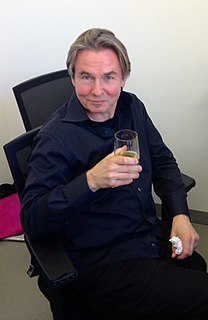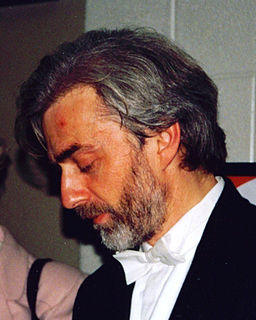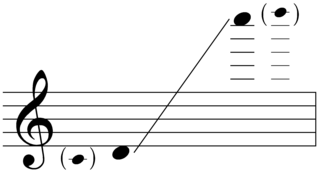
A concerto is a musical composition generally composed of three movements, in which, usually, one solo instrument is accompanied by an orchestra or concert band. It is accepted that its characteristics and definition have changed over time. In the 17th century, sacred works for voices and orchestra were typically called concertos, as reflected by J. S. Bach's usage of the title "concerto" for many of the works that we know as cantatas.

Esa-Pekka Salonen is a Finnish orchestral conductor and composer. He is principal conductor and artistic advisor of the Philharmonia Orchestra in London, conductor laureate of the Los Angeles Philharmonic, and music director-designate of the San Francisco Symphony.

Krystian Zimerman is a Polish pianist and conductor who has been described as one of the finest living pianists. In 1975, he won the IX International Chopin Piano Competition.

Magnus Gustaf Adolf Lindberg is a Finnish composer and pianist. He was the New York Philharmonic's composer-in-residence from 2009 to 2012 and has been the London Philharmonic Orchestra's composer-in-residence since the beginning of the 2014–15 season.
Béla Bartók's Piano Concerto No. 3 in E major, Sz. 119, BB 127 is a musical composition for piano and orchestra. Bartók composed the piece in 1945 during the final months of his life, as a surprise birthday present for his second wife Ditta Pásztory-Bartók. It consists of three movements.
Piano Concerto No. 3 in C major, Op. 26, is a piano concerto by Sergei Prokofiev. It was completed in 1921 using sketches first started in 1913.

Paavo Johannes Heininen is a Finnish composer and pianist. He studied at the Sibelius Academy in Helsinki, where he was taught composition by Aarre Merikanto, Einojuhani Rautavaara, Einar Englund, and Joonas Kokkonen. He continued his studies in Cologne with Bernd Alois Zimmermann; at the Juilliard School of Music in New York with Vincent Persichetti and Eduard Steuermann; and privately in Poland with Witold Lutosławski. He has also studied musicology at the University of Helsinki.
The Piano Concerto in C is a concertante work by Ralph Vaughan Williams written in 1926 and 1930-31. During the intervening years, the composer completed Job: A Masque for Dancing and began work on his Fourth Symphony. The concerto shares some thematic characteristics with these works, as well as some of their drama and turbulence.
The Concerto for Orchestra is an orchestral composition by the American composer Joan Tower. The work was jointly commissioned by the St. Louis Symphony, the Chicago Symphony Orchestra, and the New York Philharmonic.
The Asko Concerto is a concerto for chamber orchestra by the American composer Elliott Carter. The work was commissioned by the Dutch chamber group Asko Ensemble, for which the piece is titled. It was composed in January 2000 and was first performed in Concertgebouw, Amsterdam on April 26, 2000, by the Asko ensemble under the conductor Oliver Knussen. The piece is dedicated to Asko/Schönberg.
Interventions is a composition for solo piano and orchestra by the American composer Elliott Carter. The work was composed at the behest of the pianist Daniel Barenboim and the conductor James Levine to celebrate Carter's 100th birthday. The piece was completed on April 16, 2007 and was first performed in Symphony Hall, Boston on December 4, 2008 by Daniel Barenboim and the Boston Symphony Orchestra under James Levine.
The Concerto for Two Flutes and Orchestra is a composition for two flutes and orchestra by the American composer Steven Stucky. The work was commissioned by the Los Angeles Philharmonic, for which Stucky was formerly composer-in-residence and then New Music Adviser. The piece was composed from October through December 1994 and was given its world premiere in Los Angeles by the Los Angeles Philharmonic under the conductor Esa-Pekka Salonen on February 23, 1995.
The Concerto for Piano and Orchestra is a piano concerto by the American composer John Corigliano. The work was commissioned by the San Antonio Symphony and was first performed on April 7, 1968 by the pianist Hilde Somer and the San Antonio Symphony under the direction of Victor Alessandro. The piece is dedicated to John Atkins.
The Concerto for Cello and Orchestra is a cello concerto by the Polish composer Witold Lutosławski. The work was commissioned by the Royal Philharmonic Society with support from the Calouste Gulbenkian Foundation. It received its world premiere at the Royal Festival Hall on October 14, 1970 by the cellist Mstislav Rostropovich and the Bournemouth Symphony Orchestra under the direction of Edward Downes.
Kraft is a composition for solo ensemble, electronics, and orchestra by the Finnish composer Magnus Lindberg. The work was commissioned by the Helsinki Festival and was first performed on September 4, 1985 by the Toimii ensemble and the Finnish Radio Symphony Orchestra under the direction of Esa-Pekka Salonen. The piece was awarded the International Rostrum of Composers in 1986 and won the Nordic Council Music Prize in 1988.
Aura is a composition for orchestra by the Finnish composer Magnus Lindberg. The work was commissioned by Suntory for the 1994 Suntory International program for music composition. Its world premiere was given on June 11, 1994 in Tokyo by the Tokyo Symphony Orchestra under the direction of Kazufumi Yamashita. The piece is dedicated in memoriam of the Polish composer Witold Lutosławski, who died partway through its composition.
The Piano Concerto No. 2, Op. 39, is the second piano concerto by the Argentinian composer Alberto Ginastera. The work was commissioned by the Indianapolis Symphony Orchestra for the pianist Hilde Somer, to whom the concerto is dedicated. It was first performed by Somer and the Indianapolis Symphony Orchestra conducted by Izler Solomon on March 22, 1973.
The Concerto for Piano and Orchestra is a musical composition by the American composer Aaron Copland. The work was commissioned by the conductor Serge Koussevitzky who was then music director of the Boston Symphony Orchestra. It was first performed on January 28, 1927, by the Boston Symphony Orchestra conducted by Koussevitzky with the composer himself as the soloist. The piece is dedicated to Copland's patron Alma Morgenthau Wertheim.















